Moncler Bundle
How Did Moncler Conquer Luxury Fashion?
From alpine outfitter to global luxury icon, Moncler's transformation is a masterclass in strategic brand evolution. This journey, significantly shaped by the innovative 'Moncler Genius' project, has redefined the fashion landscape. Understanding Moncler's Moncler SWOT Analysis is key to grasping the intricacies of its success, from product innovation to customer engagement.
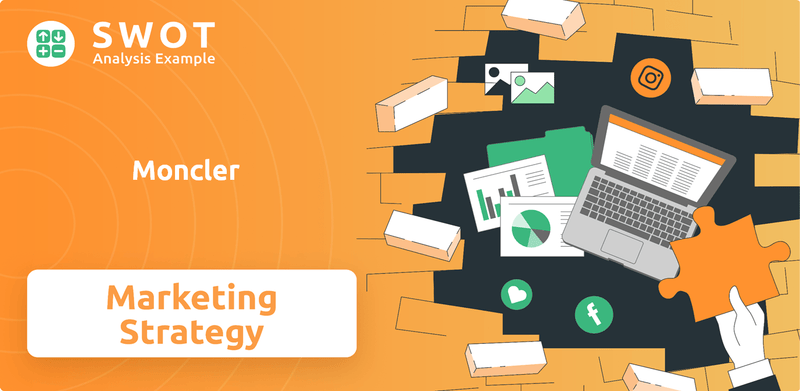
Moncler's remarkable ascent in the apparel industry showcases a potent blend of a robust Moncler sales strategy and a sophisticated Moncler marketing strategy. The company's success, highlighted by impressive revenue figures in 2024, stems from its ability to cultivate a premium brand sales approach and a strong direct-to-consumer presence. We'll delve into the specifics of Moncler's business model, exploring its digital marketing approach, collaborations, and strategies for building brand loyalty within the competitive luxury fashion marketing arena.
How Does Moncler Reach Its Customers?
The company's sales strategy revolves around a dual-channel approach, primarily focusing on direct retail and wholesale distribution. The company has strategically shifted towards a direct-to-consumer (DTC) model to enhance control over the customer experience and brand image. This approach is a key element of the overall Moncler business model.
In 2024, retail distribution was the dominant channel, accounting for 82% of net sales. The company operated a network of 376 stores, including 286 mono-brand boutiques. This strong retail presence underscores the importance of physical stores in the company's sales strategy. The DTC channel for the brand alone generated revenues of €2.33 billion in 2024, reflecting an 11% increase at constant exchange rates compared to 2023.
The wholesale channel, representing 18% of net sales in 2024, is undergoing strategic adjustments. Wholesale revenue decreased by 7% in 2024. This decline is part of an effort to optimize the distribution network and aligns with the company's broader DTC focus. The company's approach to luxury fashion marketing is evident in its channel strategy.
The retail channel, encompassing mono-brand boutiques, is a cornerstone of the company's sales strategy. The company's retail network includes 376 stores globally. The company's retail stores are designed to provide a premium brand sales experience.
The DTC channel, including both physical retail and online sales, is a key focus for the company. DTC accounted for 87% of total brand revenues in Q1 2025. The physical retail channel consistently outperforms online sales within DTC, demonstrating the value of the retail store experience.
The wholesale channel is undergoing strategic adjustments as the company prioritizes DTC. Wholesale revenue decreased by 7% in 2024. The company is working to streamline distribution and enhance its brand image.
The company is actively expanding its retail presence with new store openings. New store openings in Q4 2024 included locations in London and Boca Raton. A flagship store is planned for Fifth Avenue in New York, scheduled to open in early 2026.
The company’s shift towards DTC is designed to enhance brand control and customer experience, but it also presents certain challenges. This strategy requires careful management of wholesale partnerships and geographic reach. For a broader understanding of the competitive landscape, consider reading about the Competitors Landscape of Moncler.
- The DTC strategy aims to strengthen the brand's image and control pricing.
- Wholesale adjustments involve optimizing distribution networks.
- Store expansion is a key component of the retail strategy.
- The company's approach reflects trends in the apparel industry analysis.
Moncler SWOT Analysis
- Complete SWOT Breakdown
- Fully Customizable
- Editable in Excel & Word
- Professional Formatting
- Investor-Ready Format
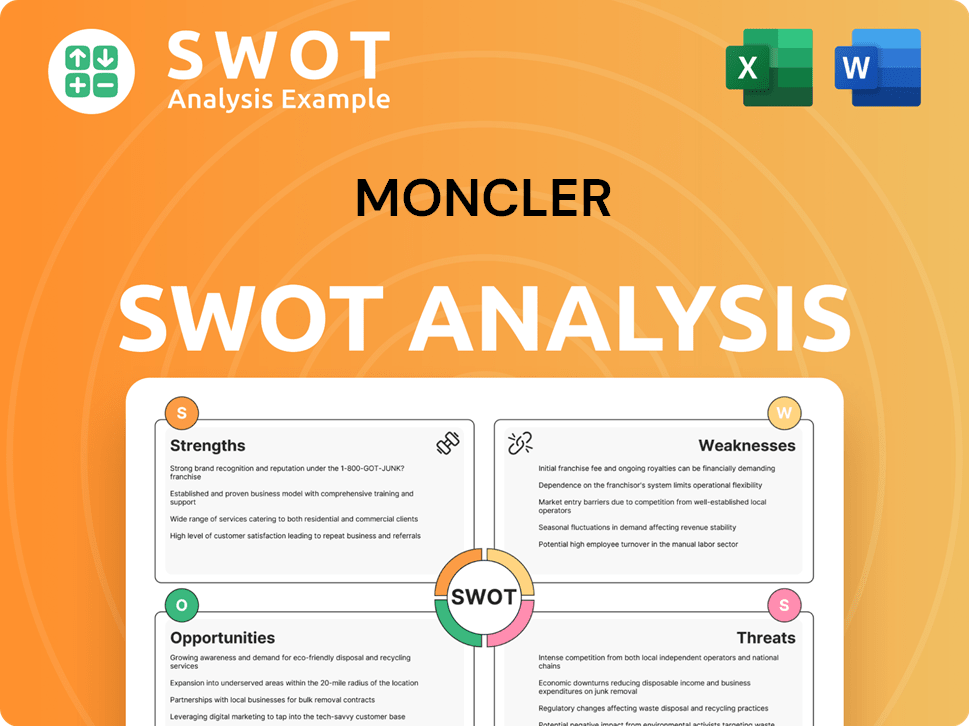
What Marketing Tactics Does Moncler Use?
The marketing tactics employed by Moncler are a blend of digital and traditional strategies, all centered around brand identity, innovation, and direct customer engagement. A key aspect of their approach is market research, which helps anticipate consumer needs and tailor campaigns effectively. This comprehensive strategy supports the company's overall Moncler sales strategy and positions it strongly in the luxury fashion market.
Digital tactics are a cornerstone of Moncler's marketing mix. They actively use content marketing, social media, and influencer partnerships to boost brand awareness and drive sales. The 'Moncler Genius' project, for instance, is a powerful marketing tool that drives product storytelling and community engagement. Their commitment to digital transformation, including the full internalization of e-commerce operations in August 2024, further highlights their focus on the online channel. This approach is critical for the Moncler marketing strategy and overall Moncler business model.
Beyond digital efforts, Moncler also leverages traditional media and events to enhance its brand presence. High-concept brand experiences, such as the Moncler Grenoble Fall/Winter 2025 collection unveiling, are designed to be immersive and reflect the brand's heritage. These events, combined with targeted digital campaigns, help shape the brand's image and attract a discerning clientele. This multifaceted approach supports the company's premium brand sales and contributes to its success in the apparel industry.
Moncler heavily invests in digital marketing, including content marketing and social media campaigns. They also partner with influencers to increase brand awareness and drive sales. This digital focus is a key component of their overall strategy.
The 'Moncler Genius' project is a prime example of innovative marketing. It generates significant media coverage and social media buzz through collaborations with renowned designers and artists. This project is a key driver for community engagement.
Moncler has fully internalized its e-commerce operations as of August 2024, and launched a new website with enhanced brand storytelling. This move underscores its commitment to the online channel. This is part of their strategy to enhance their e-commerce strategy.
Moncler hosts high-concept brand experiences, such as the Moncler Grenoble Fall/Winter 2025 collection unveiling. These events are designed to be immersive and reflect the brand's unique identity. This approach enhances the retail experience.
In 2024, Moncler's marketing expenses were €221.2 million, representing 7.1% of revenues. The company anticipates higher marketing spending in the first half of 2025 compared to 2024. This demonstrates a substantial investment in brand development.
Moncler focuses on data-driven marketing and customer segmentation to enhance personalization and engagement. This approach helps the company tailor its marketing efforts to specific customer segments. This is crucial for their customer relationship management.
Moncler's marketing tactics are designed to build brand loyalty and drive sales through a combination of digital and traditional methods. The company's commitment to innovation and customer engagement is evident in its marketing strategies. For more insights into the financial performance of Moncler, you can explore the Owners & Shareholders of Moncler.
- Content Marketing: Creating valuable content to attract and engage the target audience.
- Social Media: Utilizing platforms to build brand awareness and interact with customers.
- Influencer Partnerships: Collaborating with influencers to reach a wider audience.
- Brand Experiences: Hosting events and creating immersive experiences to reflect the brand's identity.
- E-commerce: Enhancing the online shopping experience through a dedicated website.
Moncler PESTLE Analysis
- Covers All 6 PESTLE Categories
- No Research Needed – Save Hours of Work
- Built by Experts, Trusted by Consultants
- Instant Download, Ready to Use
- 100% Editable, Fully Customizable
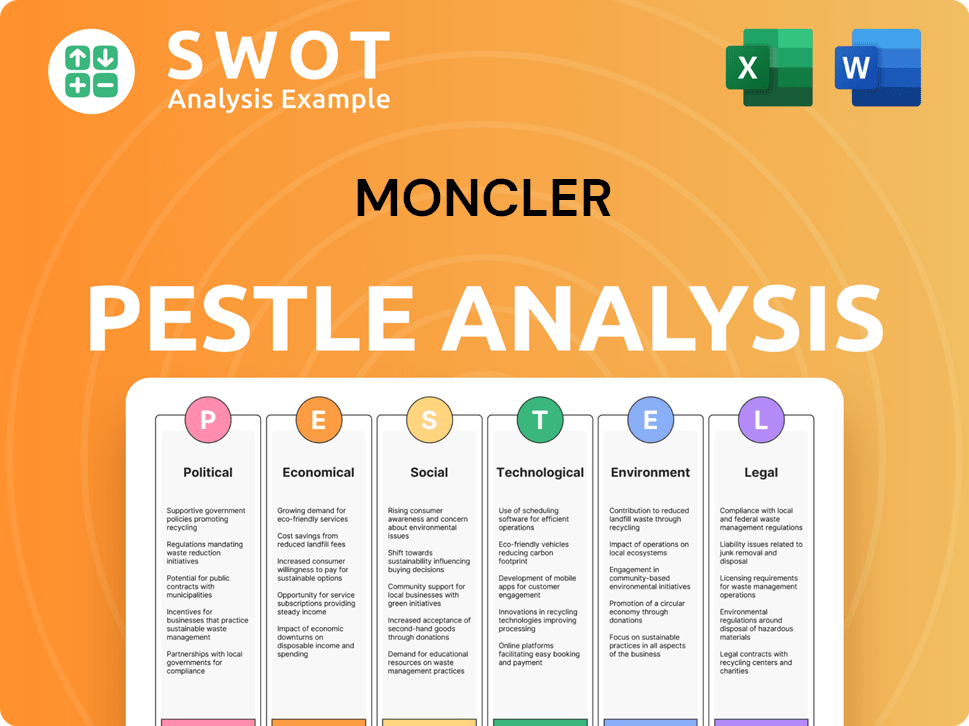
How Is Moncler Positioned in the Market?
The brand positioning of Moncler is carefully crafted to blend luxury, heritage, innovation, and technical performance. This strategy sets it apart from competitors in the apparel industry. Its core message, 'born in the mountains, living in the city,' highlights its evolution from a functional outdoor gear manufacturer to a global leader in high-end fashion. This positioning allows Moncler to appeal to a wide customer base, including those seeking high-performance outerwear and luxury clientele.
The iconic cockerel logo and felt appliqué badge are visual symbols of its heritage and commitment to quality. Moncler's brand differentiation is strengthened through strategic innovation, particularly the 'Moncler Genius' project. This initiative generates excitement and scarcity through limited-edition collaborations, elevating the brand's position in the premium outdoor segment. These collaborations allow Moncler to appeal to different customer segments without diluting its core identity. This approach is a key part of its Moncler marketing strategy.
Moncler's appeal lies in its promise of quality, versatility, and continuous evolution, staying true to its DNA. The company's Moncler sales strategy is supported by a strong financial performance, with an EBIT margin of 29.5% in 2024, which is comparable to ultra-luxury peers like Hermès. This strong financial health and premium market standing are crucial for its continued success in the luxury fashion marketing sector. To understand the revenue streams and business model of Moncler, you can explore the details in Revenue Streams & Business Model of Moncler.
The brand's heritage is visually represented by the cockerel logo and felt appliqué badge, symbolizing its commitment to quality. This focus on heritage and quality is a key component of its premium brand sales strategy. This helps build brand loyalty.
The 'Moncler Genius' project drives innovation through limited-edition collaborations with renowned designers. These collaborations enhance the brand's positioning in the premium outdoor segment. This approach helps Moncler stand out from fast-fashion competitors.
Moncler maintains brand consistency through its direct-to-consumer (DTC) channels, which account for a significant portion of its revenue. This strategy ensures control over pricing and the overall customer experience. This is a key part of Moncler's e-commerce strategy.
Moncler's resilience in the face of a global slowdown in luxury spending is evident in its climb to fourth place on Bernstein's Social Media Index in 2024. This success is bolstered by the Genius event in Shanghai. This reflects the effectiveness of its digital marketing approach.
Moncler's brand positioning strategy includes several key elements that contribute to its success in the luxury market. These elements are crucial for understanding Moncler's competitive advantage in the luxury market.
- Luxury and Heritage: The brand's focus on quality and its iconic logo.
- Innovation: The 'Moncler Genius' project and other collaborations.
- Versatility: Products designed for both performance and urban environments.
- Consistency: Maintaining a strong brand presence through DTC channels.
- Market Performance: Strong financial results and social media presence.
Moncler Business Model Canvas
- Complete 9-Block Business Model Canvas
- Effortlessly Communicate Your Business Strategy
- Investor-Ready BMC Format
- 100% Editable and Customizable
- Clear and Structured Layout
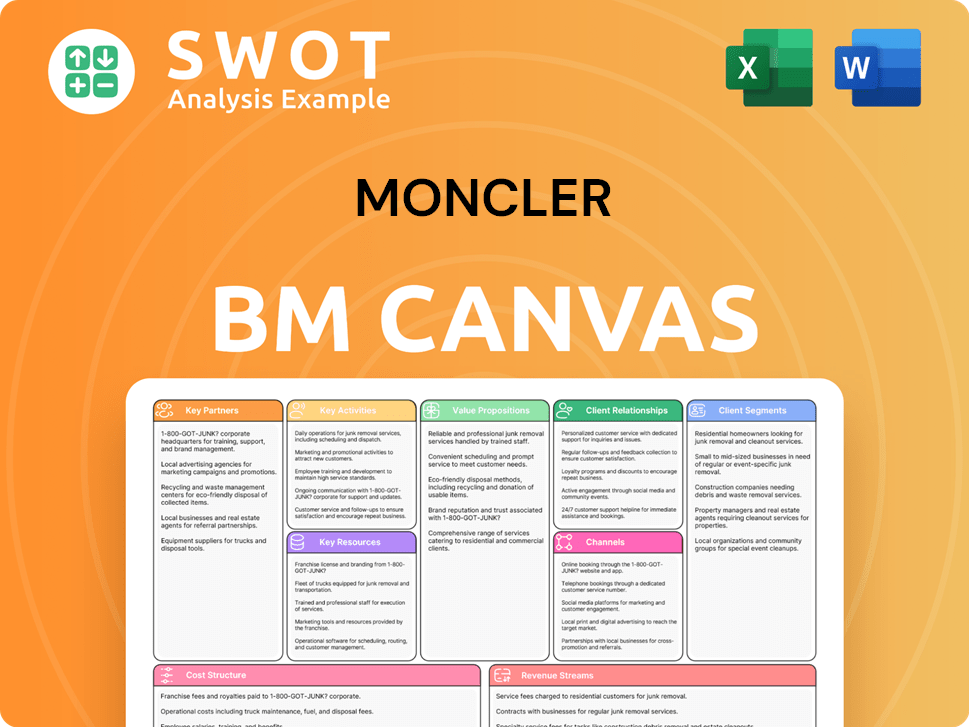
What Are Moncler’s Most Notable Campaigns?
Recent sales and marketing campaigns of the company are defined by their innovative approach to collaborations and immersive brand experiences, significantly driving brand visibility and growth. A key initiative is the 'Moncler Genius' project, launched in 2018. This structural shift in product development involves frequent collaborations with multiple designers, each reinterpreting the brand identity. This aims to generate buzz and scarcity through limited-edition collections, differentiating the brand from competitors. This approach is a core element of the Moncler sales strategy.
One of the most impactful campaigns from the Genius project was 'The City of Genius' event in Shanghai in October 2024. This immersive experience, set in a 30,000 square-meter space, showcased 10 unique designer neighborhoods. This event was described by CEO Remo Ruffini as 'the most impactful one in the brand's history'. This event contributed to the company climbing to fourth place on Bernstein's Social Media Index in 2024. This showcases the effectiveness of the Moncler marketing strategy.
Another key campaign is the Moncler Grenoble Fall/Winter 2025 collection unveiling in Courchevel, France. This elevated the brand's positioning in the premium outdoor segment. The Moncler Grenoble line accounts for 10% of sales and is growing faster than the core brand, demonstrating the success of dedicated marketing initiatives for its sub-brands. This demonstrates the strength of the Moncler business model.
Launched in 2018, this project involves frequent collaborations with various designers. Each designer reinterprets the brand identity, creating limited-edition collections. This strategy aims to generate buzz and differentiate the brand in the luxury fashion marketing landscape.
Held in Shanghai in October 2024, this immersive event spanned 30,000 square meters. It showcased 10 unique designer neighborhoods, merging creativity, innovation, and culture. The event significantly boosted brand visibility and social media engagement.
The Fall/Winter 2025 collection unveiling in Courchevel, France, enhanced the brand's premium outdoor positioning. The Grenoble line contributes 10% of total sales and is experiencing faster growth than the core brand. This high-concept approach generates meaningful results in product storytelling.
Collaborations with figures like Hiroshi Fujiwara (Fragment Design) and partnerships with entities like Mercedes-Benz under the Genius umbrella boost brand equity. These partnerships broaden appeal, reaching new communities, and enhancing the brand's overall image. These are essential elements of premium brand sales.
The success of these campaigns stems from a focus on brand innovation, exclusivity, and unique customer experiences. The company’s commitment to storytelling and creating added value for shoppers has yielded significant results, especially in key markets like China. Growth Strategy of Moncler outlines further details.
- Brand Innovation: Continuous evolution and fresh perspectives.
- Exclusivity: Limited editions and unique experiences.
- Customer Experience: Immersive events and engaging storytelling.
- Market Focus: Strong performance in key regions like China.
Moncler Porter's Five Forces Analysis
- Covers All 5 Competitive Forces in Detail
- Structured for Consultants, Students, and Founders
- 100% Editable in Microsoft Word & Excel
- Instant Digital Download – Use Immediately
- Compatible with Mac & PC – Fully Unlocked
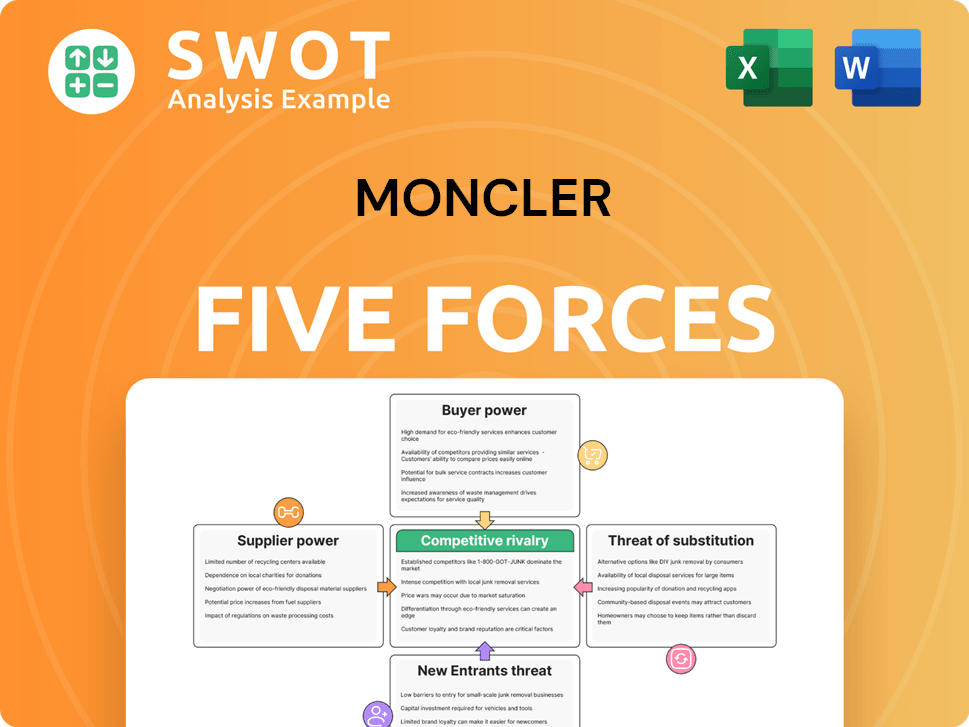
Related Blogs
- What are Mission Vision & Core Values of Moncler Company?
- What is Competitive Landscape of Moncler Company?
- What is Growth Strategy and Future Prospects of Moncler Company?
- How Does Moncler Company Work?
- What is Brief History of Moncler Company?
- Who Owns Moncler Company?
- What is Customer Demographics and Target Market of Moncler Company?
Disclaimer
All information, articles, and product details provided on this website are for general informational and educational purposes only. We do not claim any ownership over, nor do we intend to infringe upon, any trademarks, copyrights, logos, brand names, or other intellectual property mentioned or depicted on this site. Such intellectual property remains the property of its respective owners, and any references here are made solely for identification or informational purposes, without implying any affiliation, endorsement, or partnership.
We make no representations or warranties, express or implied, regarding the accuracy, completeness, or suitability of any content or products presented. Nothing on this website should be construed as legal, tax, investment, financial, medical, or other professional advice. In addition, no part of this site—including articles or product references—constitutes a solicitation, recommendation, endorsement, advertisement, or offer to buy or sell any securities, franchises, or other financial instruments, particularly in jurisdictions where such activity would be unlawful.
All content is of a general nature and may not address the specific circumstances of any individual or entity. It is not a substitute for professional advice or services. Any actions you take based on the information provided here are strictly at your own risk. You accept full responsibility for any decisions or outcomes arising from your use of this website and agree to release us from any liability in connection with your use of, or reliance upon, the content or products found herein.